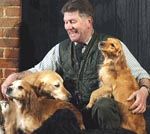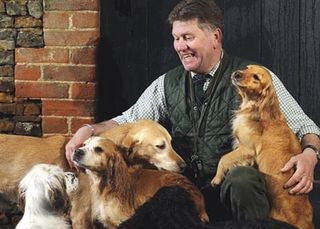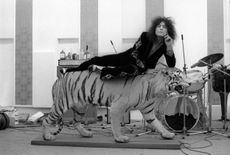Faithful friends – The Queen and her dogs
The Queen's love for her dogs is traced by Paula Lester


Visitors to The Queen's gundog kennels at Sandringham may no longer be greeted by a parrot screeching ‘three cheers for The Queen', but the establishment is testament to our Monarch's enduring love of dogs, both as pets and as working animals. ‘Her Majesty is a real countrywoman,' says Bill Meldrum, her retired gundog trainer and former head keeper at Sandringham. Having been given her first dog-a Cairn terrier-at the age of three by her uncle, the Prince of Wales, the young princess quickly developed a natural affection for animals. This rapport was further bolstered in 1933 when her father introduced a corgi, Dookie, into the household, who, when mated with a bitch called Jane, fathered two puppies born one Christmas Eve-which the young princess named Carol and Crackers.
The Queen's three current Pembroke Welsh corgis (Monty, Holly and Willow) are all descended from Susan, an 18th-birthday present. She also has three ‘dorgis' (Cider, Candy and Vulcan), a cross-breed resulting from an unplanned liaison between a corgi and Princess Margaret's dachshund Pipkin. When at Buckingham Palace, the corgis and dorgis sleep in raised wicker baskets in a special boot room near the royal apartments, where they wander freely. When The Queen is being fitted for a dress, she carries a special magnet to pick up the pins to save the corgis pricking their paws.
The corgi is so synonymous with royalty that one forgets The Queen's equal devotion to gundogs. The kennels at Sandringham, established by Edward VII in 1879 to house 100 dogs, are now home to some 20 gundogs, labradors and cocker spaniels of varying ages. Since 2004, Alan Goodship has run the pristine set-up, which now features wooden kennels and weld mesh runs, as opposed to the original local carr-stone buildings and railings. Previously a beatkeeper on the estate for more than 30 years, Alan, 54, no longer competes the dogs in field trials, concentrating instead on training them and being a member of the picking-up team on shoot days, which he fits in around looking after the dogs that are fed twice and exercised three or four times a day. ‘It's an honour. I've always enjoyed them since I worked with Bill Meldrum when I was a boy.'
In the past, The Queen has explained that she keeps mainly labradors because she felt it was the ‘normal thing to do', following her father, George VI who, in turn, continued the breeding programme of his father, George V, who founded the Sandringham strain of black labradors in 1911. It seems, however, that the young Elizabeth was not content to just sit back and watch. At Balmoral, she would take the corgis out onto the moor to help find the grouse. However, although the corgis were expert at locating the shot birds in the heather, they had difficulty retrieving them. So she would watch them wind the game and then rush over to retrieve the grouse herself.
It was The Queen's wise appointment of Mr Meldrum in 1964, whom she'd seen competing at the 1962 Retriever Championship a title he won in 1963 with field trial champion (FTCh) Glenfarg Skid and in 1975 with Lugwardine Jade-that was to catapult Sandringham to the top of the trialling tree.

The Queen and Mr Meldrum set out to bring new blood into the kennels and began a breeding programme using Skid and Jack Chudley's FTCh Creedypark Digger. Her Majesty's ambition was to own a field-trial champion, a feat that Mr Meldrum achieved five times during his 50-year tenure, with Sherry of Biteabout, Sandringham Salt, Sandringham Ranger, Sandringham Slipper and, perhaps most famous of all, Sandring-ham Sydney, so named because he was born when Her Majesty was in Australia.
Indeed, The Queen thinks of the names for all the puppies at the kennels. One of her current labradors, Gryffindor, is from a litter named after ‘Harry Potter' characters, and The Duke of Edinburgh's liver and tan cocker, Monty, was christened for the late Monty Christopher, Sandringham head keeper. Latterly, Her Majesty has been breeding and working cocker spaniels, which she values for their ability to retrieve game from difficult and dense cover.
Sign up for the Country Life Newsletter
Exquisite houses, the beauty of Nature, and how to get the most from your life, straight to your inbox.
The Queen's picking-up ability is well known. She often collects four dogs (usually three labs and a cocker) from the kennels on the morning of a shoot day, and, having loaded them into the back of her Range Rover, joins the picking-up team. ‘She was, and still is in my opinion, a very good handler who has a great knowledge of what a dog should do,' says Mr Meldrum.
The late Country Life writer John Humphreys recalled a much-talked-about occasion that saw her make a memorable retrieve with her black labrador bitch, Sherry. ‘The story is told of a hard-hit grouse at Balmoral flying into the distance, but collapsing and dying on a tumulus of heather raised like a table above the surrounding moor,' recalled Mr Humphreys. ‘It was a long retrieve [estimated at 800 yards], and time and again, The Queen got the dog to the area, but, as it had flushed a live grouse from the same spot, she had difficulty persuading the dog to keep hunting on the peat hag. She was so involved she didn't realise the drive had ended and that the shooting party had gathered behind her.
‘At last, Sherry hit the scent, picked the bird and came galloping back. There was a spatter of applause and The Queen was overcome with embarrassment, saying that she could never have done that had she known all those people were watching.'Sydney, however, proved more of a man's dog. ‘He was a really good dog, who loved to be handled and knew when he was being watched -he was so stylish,' Mr Meldrum recalls.
The Queen is not so involved with training nowadays, but she still works her dogs at every opportunity, and it's clear that they are a great source of contentment. Some royal watchers suggest that Her Majesty's fondness for her dogs is because she didn't go to school as a child and so had few human playmates. But it seems to me that she is like anyone else who cannot be without a labrador at their side-she just adores her dogs.
‘Faithful Companions', an exhibition at Sandringham, Norfolk (until November 4, www.sandringhamestate.co.uk), will feature private artworks reflecting the affection of both The Queen and of her great-grandmother, Queen Alexandra-who kept many exotic breeds, from Pekingese to Russian Borzois-for their dogs
to Country Life and save £1 per week
-
 Dawn Chorus: A Blue Plaque for Marc Bolan, holidaying in the Caribbean with Francis Ford Coppola and a history of the National Gallery in 25 pictures
Dawn Chorus: A Blue Plaque for Marc Bolan, holidaying in the Caribbean with Francis Ford Coppola and a history of the National Gallery in 25 picturesPlus the best of the property pages, and how the railways will save the countryside.
By James Fisher Published
-
 Game, set, match: 12 of the world’s most beautiful tennis courts
Game, set, match: 12 of the world’s most beautiful tennis courtsFrom Italy to Indonesia, when it comes to hotel amenities, a picturesque tennis court will always trump a 24-hour gym. So, before you book your next holiday, take a look at our pick of the 12 best.
By Rosie Paterson Last updated